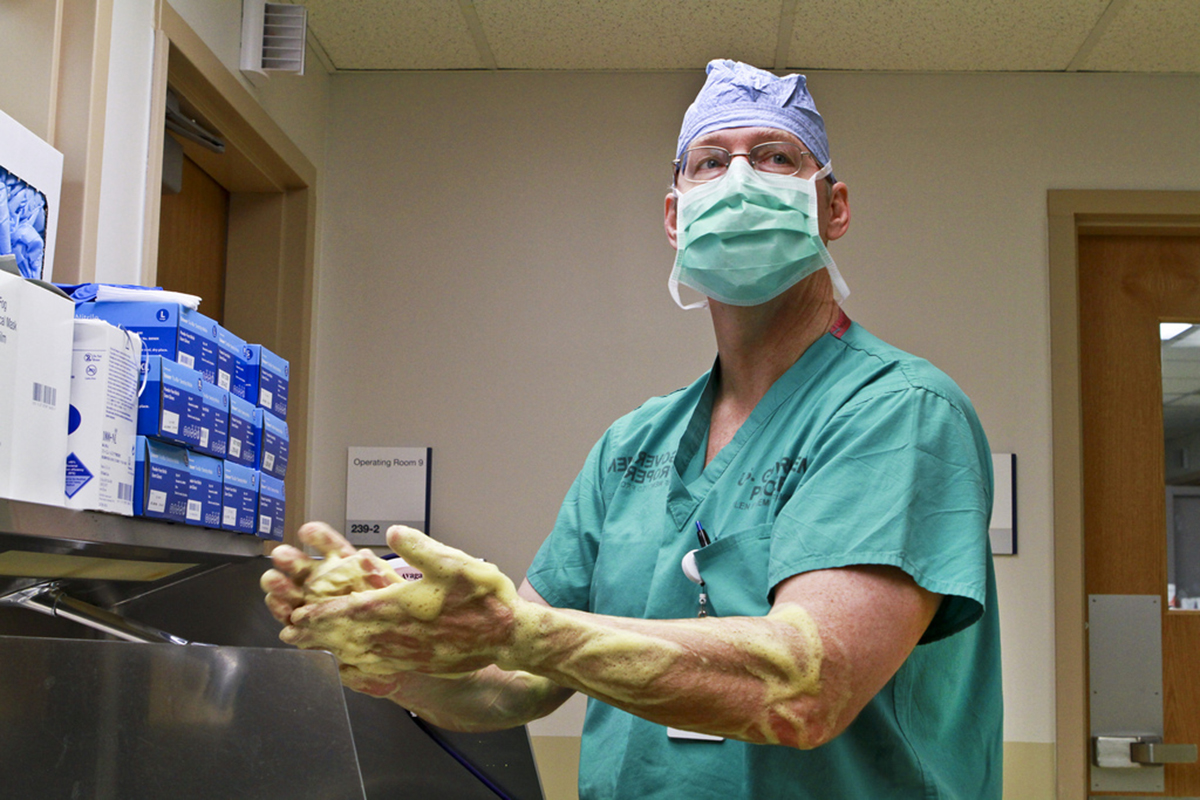Surgical scrubs are comfy. They are casual. They are a favorite attire of doctors, nurses, and surgical technicians both inside and outside the operating room.

There's no doubt that scrubs pick up bacteria. What is in question is whether those bacteria can then "jump" to another patient. Most hospitals have policies that require that surgical scrubs actually worn during surgery must be laundered after use, before wearers go into other parts of the facility. However, most hospitals and clinics do not have policies prohibiting the wearing of scrubs that have not been worn in the OR anywhere in the hospital and even in restaurants, in private cars, on buses, and at home.
One expert on the transmission of bacterial infections by surgical attire, Dr Julia Sammons, medical director of the department of infection prevention and control at the Children's Hospital of Philadelphia, told reporters for an online publication called Newsworks that there simply is not enough scientific evidence that scrubs worn outside the hospital can pass on infections. "Until robust evidence exists, or more robust clinical studies are done, our focus is more on evidence-based practices, including hand hygiene, the isolation of patients with communicable diseases, and disinfecting of the environment. These things have strong evidence behind them for reducing the press of germs in hospitals."
Common sense, it is often noted, is not necessarily common. The very idea of washing hands before and after surgery, for example, was vigorously resisted by doctors when an Austrian surgeon named Ignaz Semmelweiss introduced it in 1847. Chances are that, if you live near a medical center, you will encounter many off-duty doctors, nurses, and lab and surgical technicians running around hospital scrubs, and there's not a lot you can do about it.
New fabrics for surgical gowns kill viruses and bacteria before they can be transmitted.
Sometimes you will look up from the operating table in the OR and you'll see doctors and nurses dressed in what looks like raincoats. New, non-woven fabrics, consulting of multiple layers of plastics (usually a plastic outer layer, a plastic film middle layer, and a polyester inner layer) can actually trap microorganisms as small as HIV and as large as many kinds of parasites and bacteria. These uniforms protect medical personnel as well as subsequent patients.
See Also: Are American Doctors Underpaid?
New materials for gloves reduce the risk that a doctor will transmit germs from his or her hand to the patient.
Doctors and nurses and surgical technicians "scrub in" before surgery, carefully washing their hands and nails to make them free of bacteria. Inevitably, however, they miss a few microbes that can begin to grow and multiply in just minutes. Surgical gloves are often nicked, stretched, or cut, giving these bacteria a chance to escape and infect the patient.
More Ways To Prevent (Or Not To Prevent) The Spread Of Infection
Gloves and gowns are universally required in modern, well-equipped surgical theaters. They definitely reduce the spread of infection. They are not universally help in the intensive care unit (ICU) or patient rooms, however, and having nurses and visitors wear gloves and gowns is not known to prevent infections with either MRSA (methicilin-resistant staph) or VRE (vancomycin-resistant enterococcus).

It is not just gowns and gloves that can protect patients. Almost any article of clothing can be manufactured in a way that reduces the risk of infection when people are particularly vulnerable. However, some common health practices most of us assume help stop the spread of infection really don't.
Covering a cough doesn't actually stop the spread of infection.
This article is not suggesting that you shouldn't cover your mouth when you cough. That's just polite. You should not spray little droplets of your bodily fluids on people or objects nearby you. Coverying your mouth with you hand does not, as most of us would expect, stop the transmission of disease. That is due to the fact that most of the droplets of fluid expelled by a cough are just 1 micron (one millionth of a meter, about 1/10,000th of an inch) wide. These tiny particles leak through your fingers or even a handkerchief or a Kleenex tissue, floating in the air until they come in contact with a surface. The microorganisms that cause tuberculosis or flu can easily ride in a sphere of liquid just 1 micron across.
Wearing a face mask, on the other hand, reduces the risk of catching an infection.
When Chinese scientists studied the transmission of the bird flu virus in 2009, they discovered that unifected passengers seated in the same airplane cabin as infected passengers for up to 10 hours did not catch the virus if they wore face masks. Why should covering your mouth not stop the transmission of the virus if you are sick while wearing a face mask does if you are well?
The answer is that it takes more than just one virus, or 10 viruses, or 100 viruses to cause an infection. The immune system can defeat a small number of viruses so that symptoms never occur. It cannot overcome a massive "invasion" of the virus. Wearing a face mask keeps the number of virus particles actually getting through to a very low level so flu symptoms are avoided.
See Also: Doctor Suicides: A Growing Epidemic
The single most effective method of stopping the spread of infections is washing hands.
Overall, more effective than plastic gowns, antimicrobial gloves, and face masks is the simple act of washing hands. Protective gear is a must in the OR, but hand washing is a necessity anywhere medicine is practiced. Gloves don't really protect against infection unless they are changed after every patient contact. Putting used gloves in a box of clean gloves can contaminate the entire box.
- Scott M. Should scrubs be worn only inside hospitals to limit the spread of germs? Newsworks. January 15, 2015. http://www.newsworks.org/index.php/local/the-pulse/77247-should-scrubs-be-worn-inside-hospitals-only-to-limit-the-spread-of-germs Accessed 8 April 2015.
- Zayas G, Chiang MC, Wong E, MacDonald F, Lange CF, Senthilselvan A, King M. Effectiveness of cough etiquette maneuvers in disrupting the chain of transmission of infectious respiratory diseases. BMC Public Health. 2013 Sep 8. 13:811. doi: 10.1186/1471-2458-13-811.PMID: 24010919.
- Photo courtesy of Walt Stoneburner via Flickr: www.flickr.com/photos/waltstoneburner/3373057519
- Photo courtesy of Army Medicine via Flickr: www.flickr.com/photos/armymedicine/7093478345


Your thoughts on this